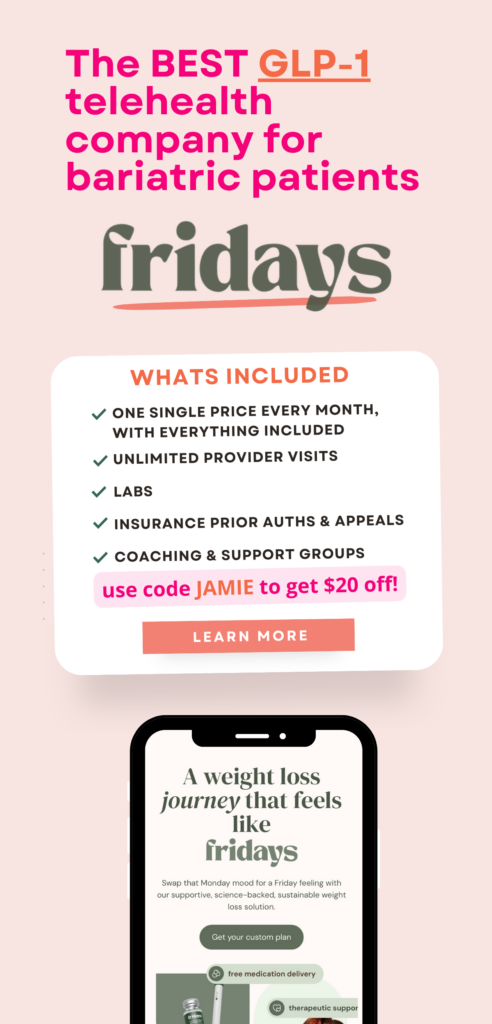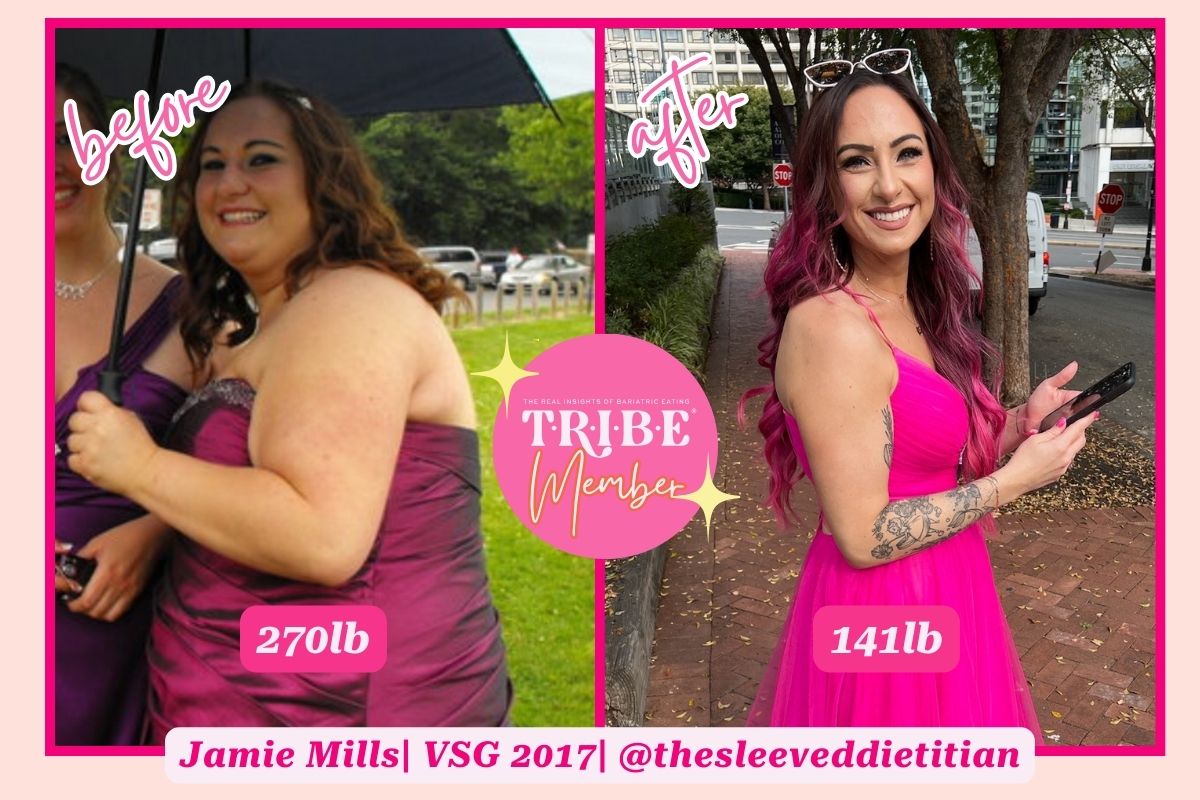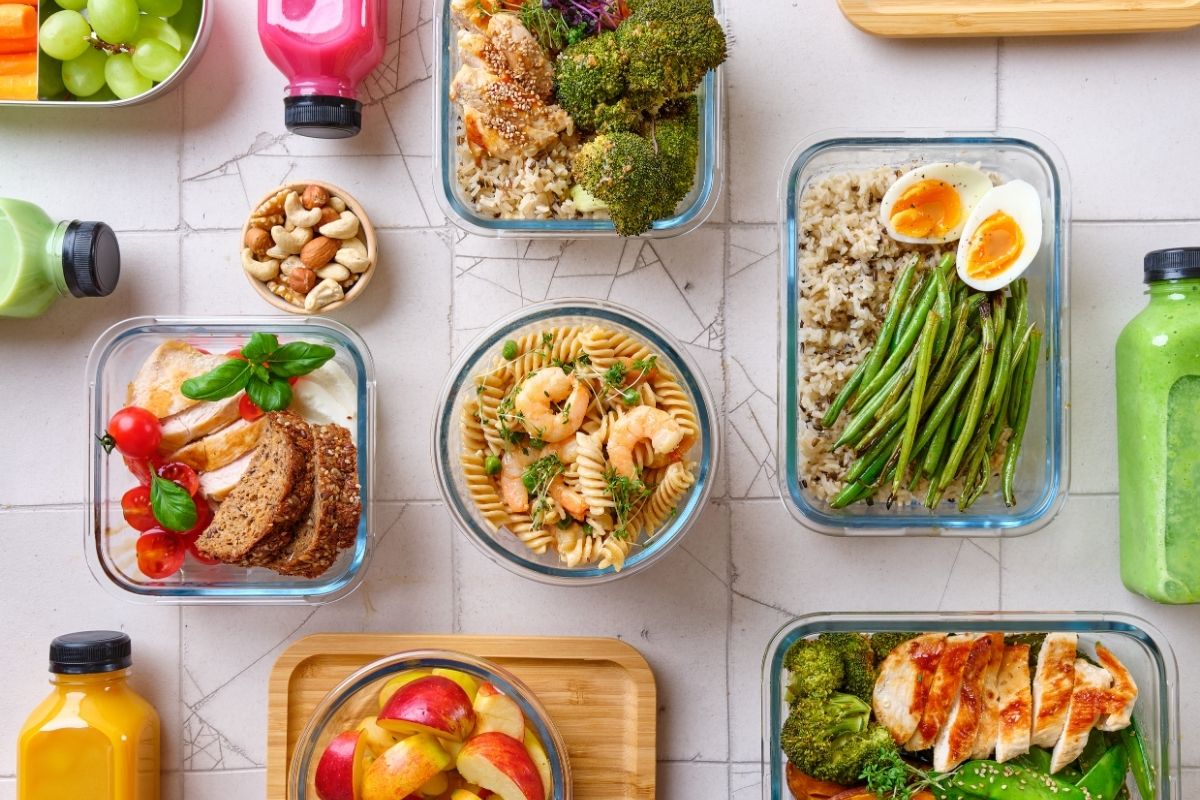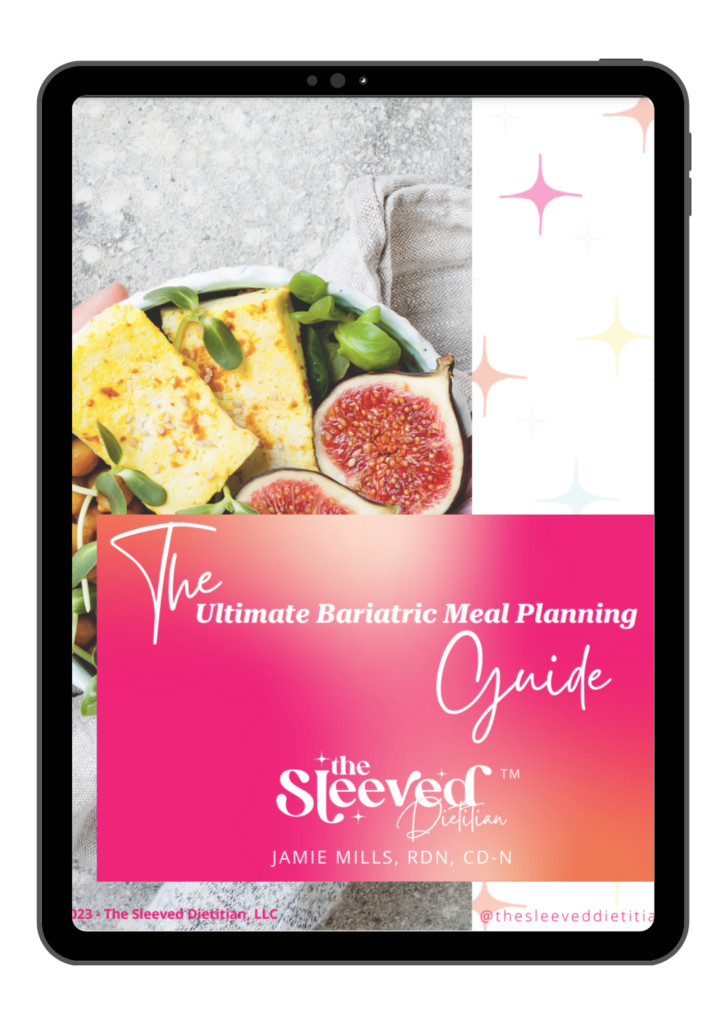So you’re on semaglutide and ready to start losing weight. Now what? You know you need to eat accordingly if you want to lose weight and minimize side effects while on semaglutide but you have no idea where to start, what to eat, or how to change your diet in order to hit your goals. Here’s your semaglutide diet plan PDF to get you started.
Hi I’m Jamie! I’m a registered dietitian who specializes in bariatrics, weight loss, and nutrition for people on GLP-1s. Not only do I love supporting people on their weight loss journeys, but I’ve been on one myself and have experienced these medications firsthand!
In today’s deep dive I’ll explain what semaglutide is, why you need a diet plan while on it, exactly what that diet plan should look like, and foods to focus on while on your GLP-1 journey so you can have a clear plan to hit your goals!
What is semaglutide?
Semaglutide is a GLP-1 medication. If you’ve spent any bit of time on social media or watching TV over the last year you’ve probably heard of “Ozempic” or “Wegovy,” both of which are the band names of these injectable medications.
GLP-1 helps manage blood sugar levels by increasing insulin production, inhibiting glucagon, and slowing gastric emptying, which is the rate at which we digest food. GLP-1 medications mimic the naturally occurring GLP-1 hormone in our bodies.
One of the reasons GLP-1 medications have become increasingly popular is because one of the main benefits of them beyond blood sugar control is weight loss.
Weight loss ultimately occurs while on these medications because when you are injecting semaglutide at a therapeutic level and your body is receiving it at a continuous rate, your hunger decreases, your satiety (satisfaction when eating) increases, cravings and “food noise” aka the constant thoughts about food decreases, and as a result weight loss occurs.
In 2021, Wegovy, which is another brand name for Semaglutide, was FDA approved for weight loss.
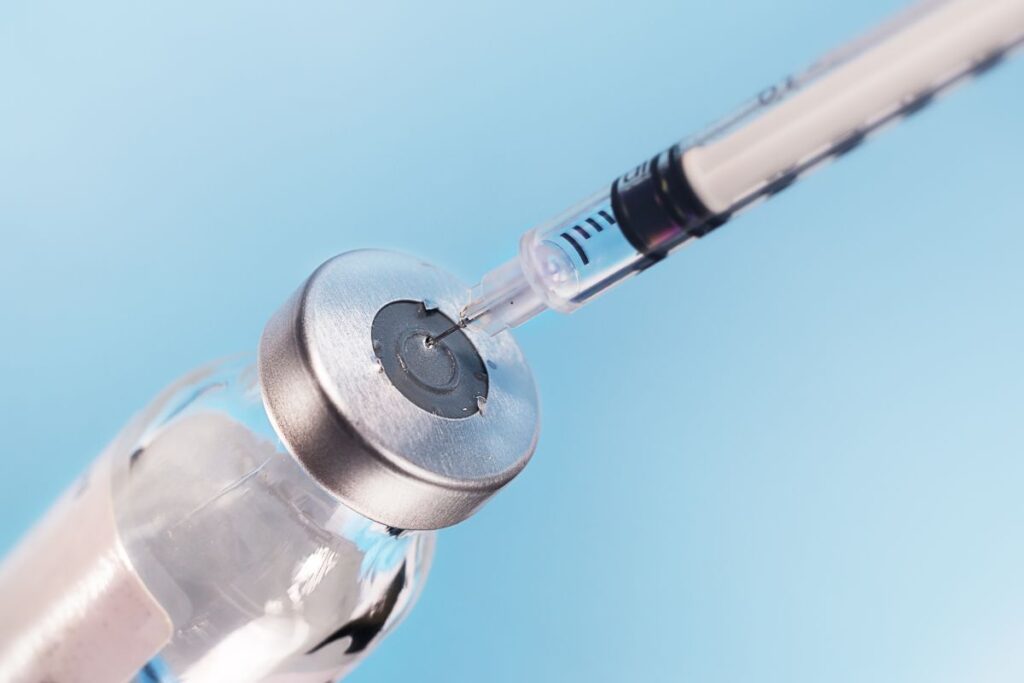
Why you need a diet plan on semaglutide
While these medications are phenomenal for weight loss, with semaglutide resulting in up to 12-15% total body weight loss over a 68-week period, they are a tool just like anything else.
There’s the common misconception that semaglutide is “cheating” or the “easy way out” and that you don’t have to work hard to lose weight while on it. And while the medications certainly help, you still need to eat right and stick to a diet plan when on semaglutide.
Not only is it important to still eat healthy in order to lose the weight you likely want to lose if you’re on one of these medications, but there are some other important considerations too that make having a diet plan super important.
Minimizing Side Effects
Aside from eating well to get the weight loss results you want, eating to manage side effects is really important. Just like with any medication, side effects can come with the territory. Because of the way semaglutide slows gastric emptying gastrointestinal (GI) symptoms can occur.
Some common symptoms include: constipation, diarrhea, and nausea. In order to minimize and manage these symptoms, having the appropriate diet plan is important.
Your semaglutide diet plan to minimize symptoms should include:
- Small frequent meals (which means eating smaller portions more often throughout the day) to minimize nausea.
- Reducing your intake of refined sugar and fatty foods. Too much sugar and fatty foods on these medications can sit extra heavy in your stomach and cause nausea or discomfort.
- Increased fiber intake. Fiber helps manage and regulate your bowel movements. The best sources of fiber are fruits, vegetables, legumes, beans, and whole grains.
- Increased water intake. Increased water is important to manage constipation, especially in combination with adequate fiber intake. Increasing water is also super important if you are experiencing diarrhea to maintain adequate hydration.
Another reason to have an appropriate diet plan on these medications is to make sure you’re maintaining your muscle mass. While losing weight on these meds is amazing and can truly be life changing, the weight you lose is total body weight reduction, not just fat reduction. What that means is not only are you likely to lose fat mass, but you’re likely to lose muscle mass as well.
Why do we NOT want to lose muscle mass?
Muscle mass is so important for the overall functioning of our bodies. Average muscle mass for men is approximately 18-24% while the average muscle mass for women is approximately 14-20%. Dropping lower than that can have negative consequences including muscle wasting which can lead to protein malnutrition.
Having adequate muscle mass on your body is also really important if you want to maintain your weight loss long term. While muscle does NOT weigh more than fat (a very common misconception) it IS more metabolically active.
That means the more muscle tone you have on your body the higher your basal metabolic rate is. Your basal metabolic rate (BMR) is the calories you burn at rest. The higher your BMR is, the more you can eat and burn effectively, which is what you want to do in order to maintain it long term.
Your semaglutide diet plan to minimize muscle loss should include:
- Adequate protein intake. Muscle is primarily made of protein. Protein is broken down into amino acids, which are the building blocks of protein. There are 9 essential amino acids which are critical for maintaining and building muscle mass.
- You want your protein to come from complete protein sources and protein sources of high biological value, which essentially means all the 9 essential amino acids.
- Complete sources of protein include eggs, dairy, chicken, beef, pork, fish, shellfish, and soy based products.
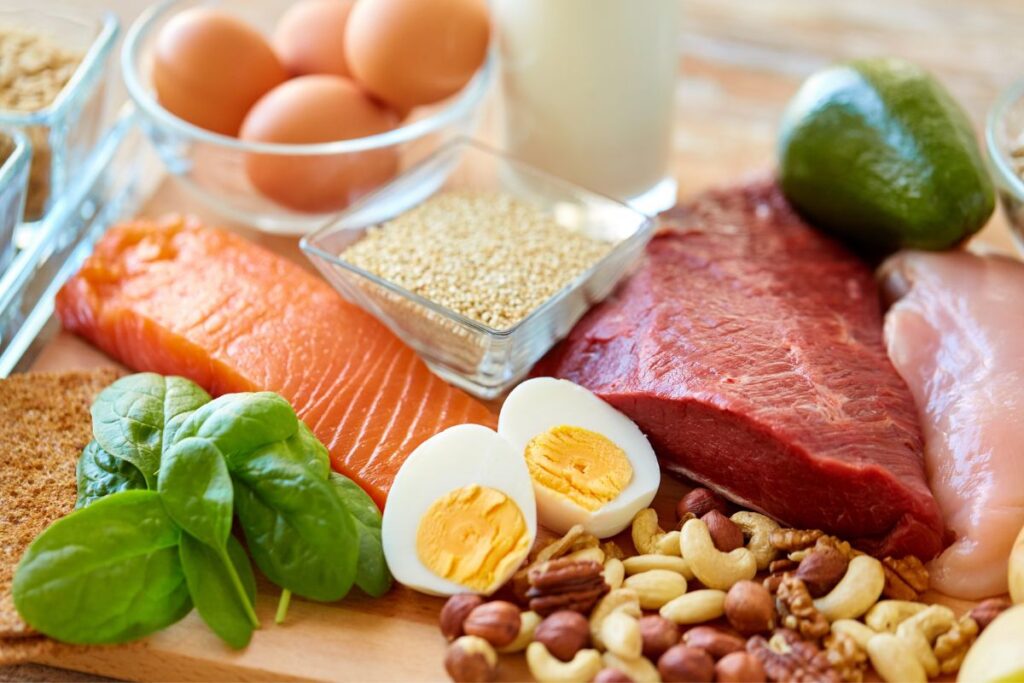
Semaglutide Diet Plan (PDF Download)
Diet plans can be tricky because everyone’s needs are different. Your individual needs will depend on your weight, height, age, gender, activity level, and weight loss/maintenance goals.
All that being said, having a semaglutide diet plan can be immensely helpful to see how your meals should be structured in order to take into account all of the nutrition considerations.
Below is a sample 3-day semaglutide diet plan. To download your full 10-day semaglutide diet plan PDF CLICK HERE.
This sample meal plan ranges from 1400-1600 calories per day and is high protein, high fiber, and low sugar and low fat. Please be sure to adjust based on your personal needs, preferences, allergies, etc.
*Please keep in mind this is a sample diet plan to help you generate ideas and is not an individualized plan. Keep in mind your individual needs may be lower or higher to hit your goals and to be appropriate for you. Always consult with your doctor or personal dietitian before making changes to your diet. This is not medical advice.
Sample Semaglutide Diet Plan
Day 1
- Breakfast:
2 scrambled eggs, 1 slice whole grain toast (28g), 1/2 medium avocado (50g) - Morning Snack:
1 medium apple (182g), 1 oz almonds (28g) - Lunch:
Grilled chicken salad with 4 oz chicken (112g), 2 cups spinach (60g), 1/2 cup cherry tomatoes (75g), 1/2 cucumber (50g), 1 tbsp olive oil (15g), and balsamic vinegar - Afternoon Snack:
1 small Greek yogurt (170g, unsweetened), 1 tbsp chia seeds (12g) - Dinner:
4 oz grilled salmon (112g), 1/2 cup cooked quinoa (93g), 1 cup steamed broccoli (150g) - Evening Snack:
1/2 cup low-fat cottage cheese (113g), 1 tbsp peanut butter (16g)
Total: 1450 calories, 55g fat, 160g carbs, 38g fiber, 35g sugar, 110g protein
Day 2
- Breakfast:
1/2 cup rolled oats (40g) with 1/4 cup mixed berries (37g) and 1 tbsp flaxseeds (10g) - Morning Snack:
1 medium banana (118g), 10 walnut halves (14g) - Lunch:
Turkey wrap with 4 oz turkey breast (112g), lettuce, tomato (100g), 1/4 avocado (30g), in a whole wheat tortilla (45g) - Afternoon Snack:
1/2 cup baby carrots (50g), 2 tbsp hummus (30g) - Dinner:
4 oz baked chicken breast (112g), 1/2 medium sweet potato (100g), 1 cup green beans (125g) - Evening Snack:
Protein smoothie made with 1 scoop unsweetened protein powder (30g), 1 cup almond milk (240ml), and 1 cup spinach (30g)
Total: 1520 calories, 50g fat, 170g carbs, 40g fiber, 28g sugar, 105g protein
Day 3
- Breakfast:
1 cup Greek yogurt (245g, unsweetened), 1/4 cup granola (24g), 1/2 cup blueberries (75g) - Morning Snack:
1 large hard-boiled egg, 1/2 cucumber (50g) - Lunch:
Grilled tuna salad with 4 oz tuna (112g), 2 cups mixed greens (85g), 1 tbsp olive oil (15g), and lemon dressing - Afternoon Snack:
1 medium pear (178g), 10 almonds (14g) - Dinner:
5 oz grilled shrimp (140g), 1/2 cup brown rice (100g), 1 cup bell peppers (150g) - Evening Snack:
1 oz cheese (28g), 1/4 cup grapes (40g)
Total: 1380 calories, 45g fat, 180g carbs, 36g fiber, 32g sugar, 108g protein
To download your full 10-day semaglutide diet plan PDF CLICK HERE.
If you’re looking for more snack ideas to add to your semaglutide diet plan CLICK HERE to read my post on easy grab – and – go snacks!
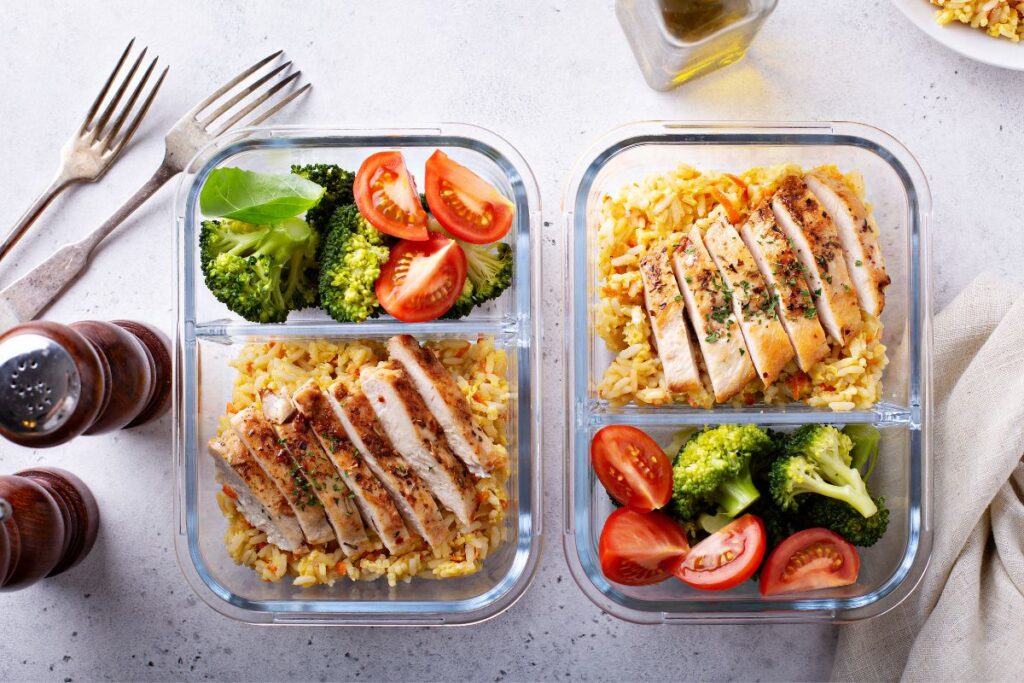
How Semaglutide Affects Appetite and Eating Habits
Believe it or not, semaglutide can make it difficult to eat. I know, as someone who struggles with their weight and often feels out of control around food, it can be hard to imagine. But it’s definitely possible, and even likely, that while on a GLP-1 medication you may not feel like eating at all.
Now, if your appetite is so minimal that you never want to eat, definitely talk to your doctor about adjusting your dose. The goal of these medications is to help you manage hunger and food noise, not eliminate it entirely!
You still need to eat and you need to eat enough! Under-eating can actually slow your weight loss, make you feel fatigued and worsen side effects, and make it that much harder to maintain your losses long term.
Having an appropriate diet plan and routine can make it easier to make sure you’re taking in a enough food and not unintentionally under eating.
Tips for Staying Consistent on Your Semaglutide Diet Plan
As someone who’s been on many diets over my lifetime I can relate to the anxiety you might already be feeling trying to stick to a new diet plan. It’s my hope that this plan gives you some structure and ideas and minimizes anxiety, not add to it!
You are not expected to follow this plan “perfectly.” Spoiler alert – there’s no such thing as perfect eating anyways!
The hope is that this plan helps take a load off your plate (haha no pun intended), and help you consistently eat enough to nourish your body, manage side effects, and hit your health and weight loss goals.
Below are some tips to help you stick to YOUR ideal plan while on semaglutide:
- Tip 1: take the 10-day semaglutide diet plan and print it! That way you have it in front of you. PDF’s and digital products are wonderful, but not if it sits in the back of your computer or phone and you never use it.
- Tip 2: Once you print it, go through it and see what you like/don’t like. If there is something you don’t like or won’t eat, try to substitute the items on the plan for something similar that you would like to eat (just note that doing so will change the macronutrient breakdown!)
- Tip 3: Find a time each week to go grocery shopping to prepare for your planned meals for the week!
- Tip 4: Switch it up! Once you get the hang of eating this way don’t be afraid to switch things up and come up with your own high protein, high fiber, low fat low sugar meals. That way, you don’t get burnt out!
- Tip 5: Put timers in your phone throughout the day to remind you to eat if you feel like you are prone to forget! While it’s important to listen to your body and eat when you’re hungry and stop when you’re full, sometimes on these medications it’s important to be proactive and eat intentionally so you aren’t accidentally under doing it.
And remember this is a plan to loosely follow, but it’s not a strict “diet.” It’s a lifestyle and what matters most isn’t following the plan to a T. What matters most is choosing high protein, high fiber options most of the time to support your goals and make sure you feel good while doing it!
Download Your Semaglutide Diet Plan PDF Here
Going on a GLP-1 medication can be overwhelming and scary, especially if you feel lost or confused about what to eat.
Remember, these medications are wonderful tools to help you hit your weight loss and health goals, but they aren’t a quick fix, and eating healthfully and eating enough are two major responsibilities you have while on these medications.
Make sure you download your semaglutide diet plan pdf HERE. And feel free to comment or ask questions below! I’m always here to help and support you.
Until next time,
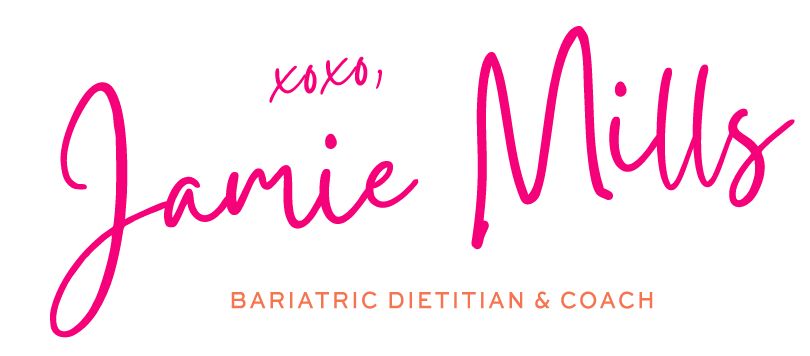
P.S.
Bariatrics and weight loss surgery is my ultimate specialty. If you’re a surgical bariatric patient on a GLP-1 medication, there are even more things to consider when it comes to your health and your goals.
To get even more support on your weight loss surgery and GLP-1 journey CLICK HERE to unlock my T.R.I.B.E. Module for $35. In this module I teach you all about what you need to do to be successful on a GLP-1 AND as a surgical bariatric patient.


